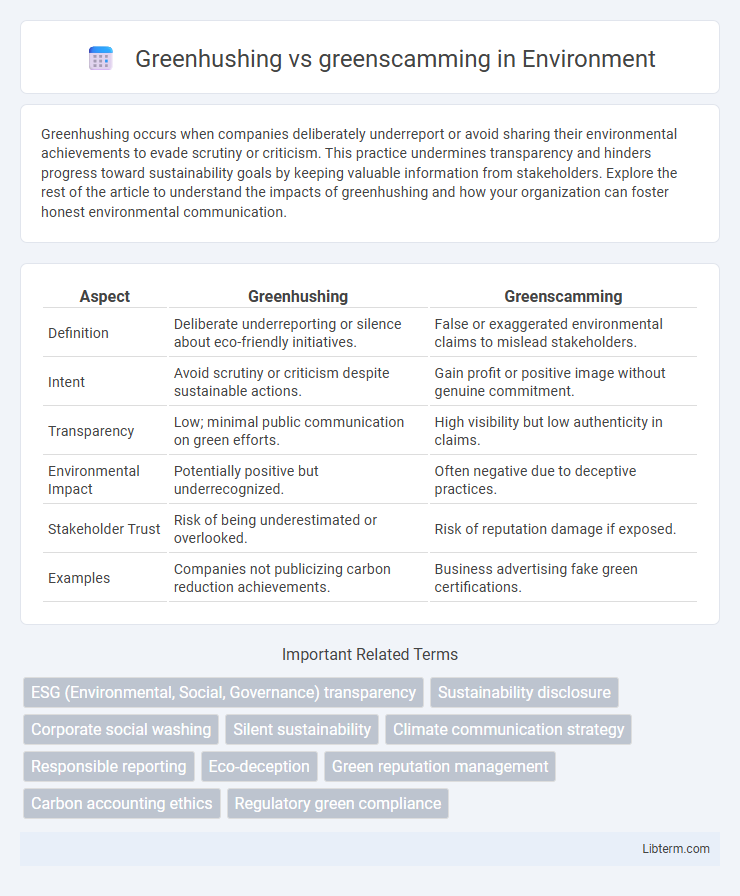Greenhushing occurs when companies deliberately underreport or avoid sharing their environmental achievements to evade scrutiny or criticism. This practice undermines transparency and hinders progress toward sustainability goals by keeping valuable information from stakeholders. Explore the rest of the article to understand the impacts of greenhushing and how your organization can foster honest environmental communication.
Table of Comparison
| Aspect | Greenhushing | Greenscamming |
|---|---|---|
| Definition | Deliberate underreporting or silence about eco-friendly initiatives. | False or exaggerated environmental claims to mislead stakeholders. |
| Intent | Avoid scrutiny or criticism despite sustainable actions. | Gain profit or positive image without genuine commitment. |
| Transparency | Low; minimal public communication on green efforts. | High visibility but low authenticity in claims. |
| Environmental Impact | Potentially positive but underrecognized. | Often negative due to deceptive practices. |
| Stakeholder Trust | Risk of being underestimated or overlooked. | Risk of reputation damage if exposed. |
| Examples | Companies not publicizing carbon reduction achievements. | Business advertising fake green certifications. |
Understanding Greenhushing: Definition and Examples
Greenhushing refers to the practice where companies deliberately underreport or hide their environmental efforts to avoid scrutiny, criticism, or regulatory pressure. Examples include businesses downplaying their sustainability initiatives or withholding carbon reduction achievements to prevent accusations of greenwashing or attracting competitive disadvantage. This phenomenon contrasts with greenscamming, where firms exaggerate or fabricate environmental claims to mislead consumers and stakeholders.
What is Greenscamming? Identifying Deceptive Practices
Greenscamming involves companies or organizations falsely portraying their products, services, or practices as environmentally friendly to mislead consumers and gain competitive advantage. Identifying deceptive practices includes scrutinizing vague claims, lack of third-party certifications, and inconsistencies in environmental impact reports. Recognizing greenscamming helps consumers avoid greenwashed offerings and encourages genuine sustainability efforts.
Key Differences Between Greenhushing and Greenscamming
Greenhushing involves companies deliberately minimizing communication about their environmental efforts to avoid scrutiny or criticism, whereas greenscamming refers to deceptive practices where companies exaggerate or fabricate their green initiatives to mislead stakeholders. The key differences lie in transparency and intent: greenhushing is characterized by silence or underreporting to sidestep accountability, while greenscamming employs false claims to create a false image of sustainability. Both practices undermine genuine corporate social responsibility but affect consumer trust and regulatory responses in distinct ways.
Motivations Behind Greenhushing in Corporate Communication
Greenhushing occurs when companies deliberately underreport or conceal their environmental initiatives to avoid scrutiny or criticism, driven by motivations such as fear of reputational risk and regulatory backlash. Corporations may also choose greenhushing to maintain competitive secrecy or avoid raising stakeholder expectations they cannot meet. These strategic considerations contrast with greenscamming, where firms exaggerate or fabricate sustainability claims to appear eco-friendly and attract favorable public attention.
The Impact of Greenscamming on Consumer Trust
Greenscamming severely undermines consumer trust by promoting false or exaggerated environmental claims, leading to skepticism toward genuine green products. Studies indicate that over 60% of consumers have become wary of eco-labels due to frequent misleading marketing tactics. This erosion of trust not only damages brand reputations but also slows the progress of sustainable consumption and corporate environmental responsibility.
Recognizing Greenhushed Companies: Red Flags and Indicators
Greenhushed companies often avoid publicizing their environmental initiatives, making it challenging to assess their true sustainability efforts due to a lack of transparent reporting or third-party verification. Key red flags include vague or minimal environmental claims, absence from recognized sustainability indexes, and limited engagement with stakeholders on climate goals. Identifying greenhushed firms requires scrutinizing inconsistencies between their operational impacts and public disclosures, alongside monitoring regulatory filings and environmental audits for hidden or understated green strategies.
Consequences of Greenscamming in Marketing and PR
Greenscamming in marketing and PR leads to severe reputational damage as consumers increasingly detect greenwashing tactics, resulting in lost trust and decreased brand loyalty. Regulatory penalties and legal repercussions also threaten companies engaging in false environmental claims, escalating financial risks. Furthermore, greenscamming erodes market competitiveness by undermining genuine sustainability initiatives and misleading stakeholders, ultimately impairing long-term business growth.
Regulatory Responses to Greenhushing and Greenscamming
Regulatory responses to greenhushing focus on increasing transparency and enforcing mandatory environmental disclosures to prevent companies from hiding their sustainability efforts. In contrast, regulations addressing greenscamming prioritize verifying environmental claims through third-party audits and imposing penalties for misleading or false green marketing. Both approaches emphasize accountability by enhancing oversight mechanisms and promoting truthful communication to protect consumers and investors from greenwashing practices.
Best Practices for Authentic Sustainability Communication
Effective sustainability communication requires transparent reporting and verifiable claims to avoid greenhushing, where companies underreport efforts, and greenscamming, where exaggerated claims mislead stakeholders. Best practices include deploying third-party audits, adopting standardized environmental metrics like the GRI or SASB frameworks, and engaging in open dialogues with consumers to build trust. Prioritizing authentic storytelling and measurable impact ensures credibility and strengthens brand reputation in the green market.
Future Trends: Combating Greenhushing and Greenscamming in Business
Future trends in combating greenhushing and greenscamming emphasize enhanced transparency through blockchain technology, enabling verified sustainability claims and preventing deceptive green marketing. Regulatory frameworks are evolving to impose stricter penalties and standardized reporting requirements, encouraging businesses to communicate authentic environmental efforts confidently. Consumer demand for credible, data-driven sustainability disclosures drives the adoption of AI-powered monitoring tools that detect inconsistencies and promote accountability in corporate green initiatives.
Greenhushing Infographic

 libterm.com
libterm.com